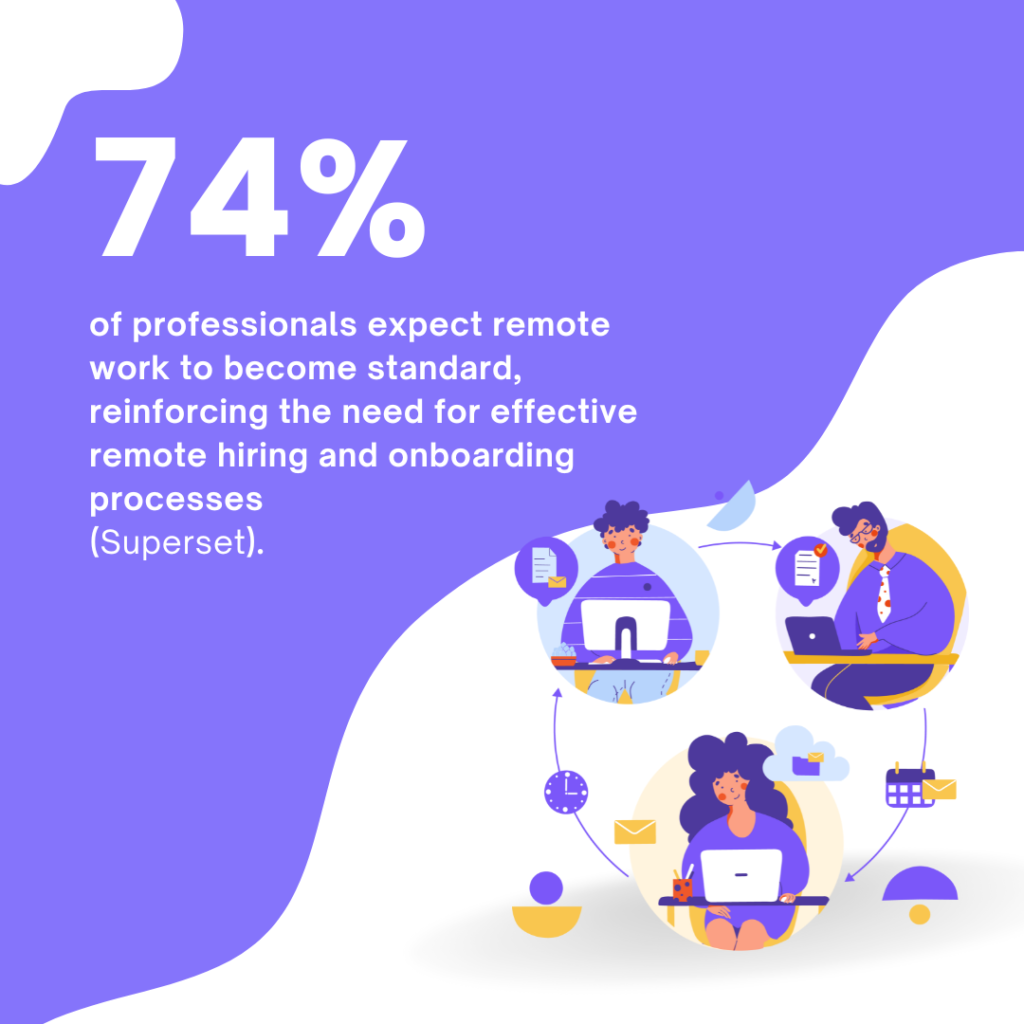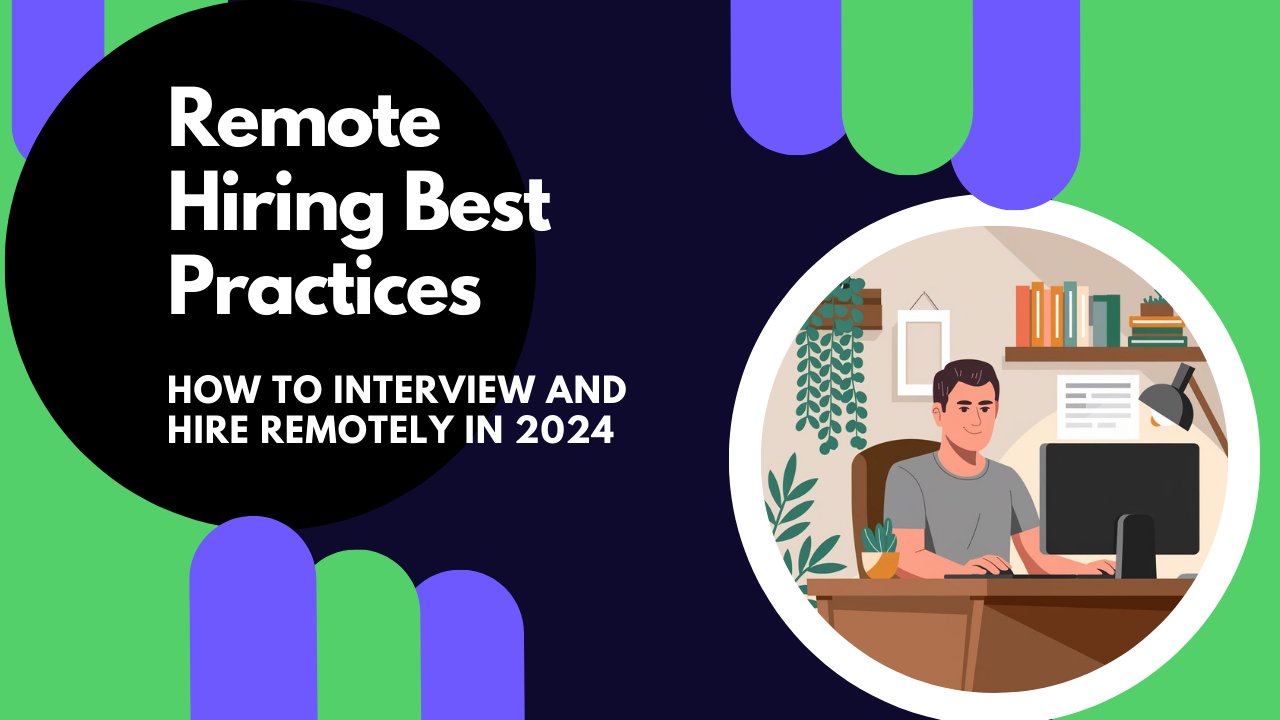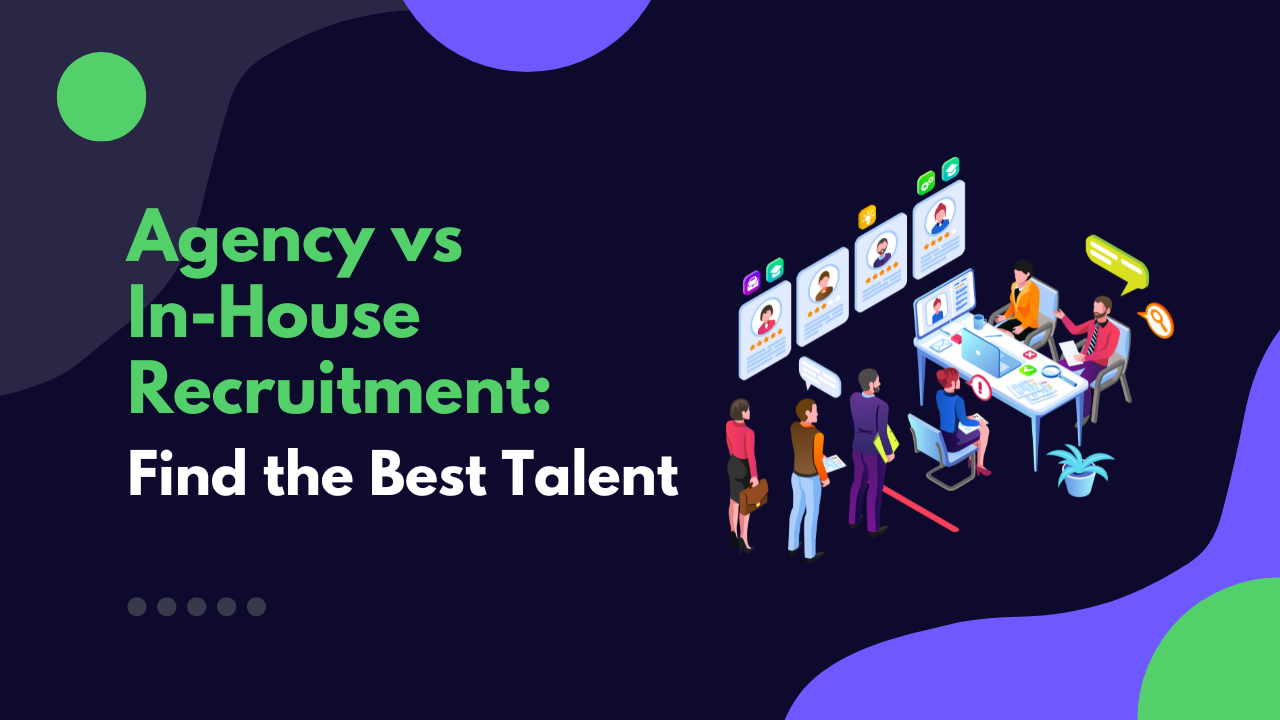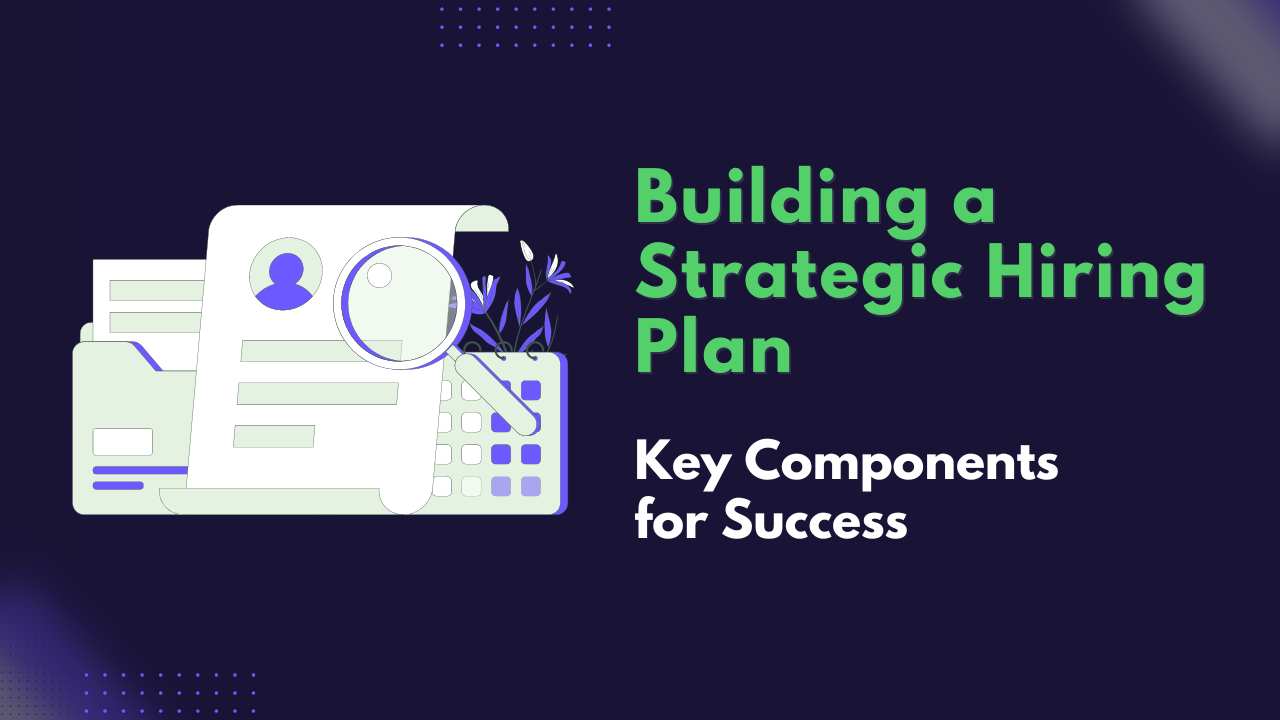The Future of Hiring: Why Remote is Here to Stay
The way we work has fundamentally changed. No longer confined by geographical boundaries, companies are embracing remote work and tapping into a global talent pool. But with this shift comes a new set of challenges – how do you find, attract, and onboard the best talent when everyone is miles apart?
Navigating the world of virtual interviews, building trust remotely, and fostering a strong remote company culture requires a new approach to hiring. It’s no longer enough to simply replicate traditional methods in a digital space.
This guide delves into the best practices of remote hiring in 2024, providing you with actionable strategies to source, screen, interview, and onboard top-tier candidates, no matter where they are. Discover how tools like TapTalent’s AI-powered platform can further streamline your remote hiring process, helping you build high-performing teams in a remote-first world.
The Growing Importance of Remote Hiring in 2024
The way we work has fundamentally changed. The shift to remote work, accelerated by recent global events, isn’t a temporary trend—it’s a permanent transformation of the business landscape.

For businesses, this means rethinking traditional hiring practices and embracing remote hiring strategies to attract and retain top talent in this evolving job market. Failing to adapt risks losing out on a significant portion of the talent pool. Fortunately, the rise of advanced communication, collaboration, and recruitment technologies makes remote hiring more efficient and effective than ever before.
Embracing remote hiring unlocks a multitude of benefits for businesses of all sizes, including:
- Access to a Wider Talent Pool: By removing geographical limitations, companies can tap into a global talent pool and find the best candidates for the job, regardless of location. This expands access to specialized skills and diverse perspectives, enriching the workforce and driving innovation.
- Cost Savings: Remote hiring can lead to significant cost savings by reducing or eliminating the need for expensive office space, utilities, and other overhead costs associated with maintaining a physical workspace. These savings can be reinvested in other areas of the business.
- Increased Flexibility: Remote work provides greater flexibility for both employers and employees, allowing for better work-life integration and improved overall well-being. This can lead to increased productivity, higher employee retention rates, and a more engaged workforce.
In today’s competitive job market, offering remote work options is no longer a perk but a necessity for attracting and retaining top talent. The benefits of remote hiring contribute to a more attractive employer brand and a positive employee experience.
Preparing for Remote Interviews
The shift to remote work has transformed the hiring process, with remote interviews becoming the new norm. Effective interviews are an integral part of remote hiring best practices. This section provides a practical guide to help you prepare for successful virtual interviews, ensuring a seamless experience for both you and your candidates.
Choosing the Right Remote Interview Technology
The right technology can make or break a remote interview. Here’s a step-by-step guide to selecting the ideal platform for your needs:
- Evaluate Your Needs: Start by considering your specific interview requirements:
- Do you need screen sharing for presentations or code reviews?
- Will you be conducting group interviews with multiple panelists?
- Do you require recording functionality for future reference?
- Research Popular Platforms: Explore leading video conferencing platforms:
- Zoom: Known for its reliability, ease of use, and robust features.
- Microsoft Teams: Offers seamless integration with other Microsoft products, making it ideal for businesses already using the Microsoft suite.
- Google Meet: Provides a user-friendly interface and integrates smoothly with Google Workspace.
- Personalized Tip: Create a spreadsheet comparing key features of each platform, such as screen sharing, recording capabilities, breakout rooms, and integration options. This will allow you to make an informed decision based on your specific needs.
- Test the Technology: Before your first remote interview, conduct test runs with colleagues:
- Familiarize yourself with the platform’s features, ensuring you know how to share your screen, mute/unmute participants, and utilize the chat function.
- Check your audio and video quality to ensure clarity.
- Personalized Tip: Schedule a test call with a colleague and practice using the platform’s features. This will help you feel comfortable and confident during the actual interview.
- Choose and Communicate: Select the platform that best meets your needs and inform the candidate about the chosen platform well in advance:
- Provide clear instructions on how to join the meeting, including the meeting link, date, and time.
- Offer technical support if needed, and be prepared to troubleshoot any issues on the day of the interview.
- Personalized Tip: When communicating with the candidate, include a link to the meeting, any necessary login details, and a contact number they can reach if they experience technical difficulties.
Setting Expectations: Clear Communication is Key
Clear communication is crucial for setting expectations and ensuring a smooth interview experience. Follow these steps to keep candidates informed and prepared:
- Pre-Interview Communication:
- Send candidates a detailed interview agenda outlining the format, duration, and topics to be discussed.
- Provide information about the interviewers they will be meeting.
- Personalized Tip: Create a standardized email template outlining the interview details, but personalize it for each candidate by including their name and the specific role they are interviewing for.
- Technical Requirements:
- Clearly communicate any technical requirements, such as software downloads, internet speed recommendations, or necessary equipment (headset, webcam).
- Personalized Tip: Include a checklist of technical requirements in the pre-interview communication. This ensures the candidate has everything they need for a smooth interview experience.
- Dress Code and Etiquette:
- While the setting is virtual, maintaining professionalism is crucial.
- Suggest a business casual dress code and advise candidates on appropriate virtual meeting etiquette (e.g., muting microphones when not speaking, minimizing distractions).
- Personalized Tip: While you want candidates to feel comfortable, it’s important to maintain a professional atmosphere. Clearly communicating expectations around dress code and etiquette reinforces this.
Creating a Professional Virtual Environment
Your virtual background speaks volumes about your professionalism. Follow these tips to create a distraction-free and professional setting for your remote interviews:
- Choose a Quiet Location:
- Select a quiet space free from distractions and interruptions.
- Inform household members about the interview schedule to minimize disruptions.
- Personalized Tip: Find a dedicated workspace where you can control the environment and minimize background noise. This could be a home office, a quiet room, or even a designated corner in your home.
- Optimize Lighting and Background:
- Ensure adequate lighting that illuminates your face clearly. Natural light is ideal.
- Choose a neutral and uncluttered background to avoid distractions. A plain wall or a professional backdrop is ideal.
- Personalized Tip: Position yourself facing a window or use a lamp to ensure your face is well-lit. Avoid backlighting, which can make it difficult for the candidate to see you clearly.
- Minimize Distractions:
- Silence notifications on your computer and phone.
- Close unnecessary applications to prevent distractions during the interview.
- Personalized Tip: Create a pre-interview checklist that includes silencing notifications, closing unnecessary applications, and putting your phone on silent. This will help you stay focused and present during the interview.
By following these guidelines, you can ensure that your remote interviews are professional, productive, and conducive to making well-informed hiring decisions.
Best Practices for Conducting Virtual Interviews
The rise of remote work has transformed the way we hire, making virtual interviews the new norm. To effectively assess candidates in a virtual setting and determine their suitability for remote work, follow these best practices:
Effective Interviews and Assessments
- Structure the Interview:
- Outline a clear interview structure, similar to in-person interviews, but tailored for the virtual environment.
- Include a mix of introductory questions, behavioral questions, technical assessments, and problem-solving scenarios.
- Personalization: Adapt questions to your company’s specific needs and the role’s requirements. For example, for a software engineering role, incorporate coding challenges.
- Incorporate Remote-Specific Assessments:
- Design assessments to gauge a candidate’s ability to thrive in a remote environment.
- Include questions about their experience with remote work tools, time management skills, communication preferences, and ability to work independently.
- Personalization: Consider a project-based assessment where the candidate completes a task relevant to the role in a simulated remote work environment.
- Leverage Collaborative Tools:
- Use collaborative tools for real-time assessments, such as shared documents for coding exercises or virtual whiteboards for brainstorming.
- Personalization: Familiarize yourself with different collaboration tools and choose the ones that best fit the role and your company’s workflow, such as Google Docs, Miro, and Figma.
Impact on KPIs: By implementing these strategies, you can expect improvements in candidate quality, reduced time-to-hire, and an enhanced candidate experience.
Evaluating Candidates’ Remote Work Readiness
- Assess Communication Skills:
- Pay close attention to the candidate’s communication skills in the virtual interview.
- Observe their clarity, conciseness, active listening, and ability to respond effectively.
- Personalization: Develop a scoring rubric for communication skills to ensure consistent evaluation across candidates.
- Evaluate Self-Management:
- Inquire about the candidate’s time management strategies, organizational skills, and ability to prioritize tasks effectively in a remote setting.
- Ask for specific examples of how they have successfully managed their time and workload in previous remote roles.
- Personalization: Prepare follow-up questions to delve deeper into their responses and gain a clearer understanding of their self-management capabilities.
- Gauge Ability to Work Independently:
- Explore the candidate’s comfort level with working independently and their ability to stay motivated and focused without direct supervision.
- Look for examples of how they’ve taken initiative and proactively addressed challenges in previous remote work experiences.
- Personalization: Craft scenarios relevant to the role and ask how the candidate would handle them in a remote setting. This assesses their problem-solving skills and ability to work independently.
Impact on KPIs: Evaluating these aspects can lead to increased employee retention, improved team performance, and reduced management overhead.
Maintaining Candidate Engagement
- Provide Timely Feedback:
- Keep candidates informed throughout the hiring process, regardless of the outcome.
- Provide prompt feedback on their interview performance and next steps.
- Personalization: Set clear timelines for providing feedback and stick to them. This shows respect for the candidate’s time and reinforces a positive candidate experience.
- Maintain Clear Communication:
- Ensure clear communication about the hiring process, expectations, and timelines.
- Answer candidate questions promptly and thoroughly.
- Personalization: Use TapTalent’s smart inbox feature to manage communication efficiently and ensure no candidate inquiries are missed.
- Personalize the Experience:
- Tailor your communication and follow-up to each candidate’s specific situation and experience.
- Personalization: Remember details from their resume or previous conversations to show you’ve invested time in getting to know them.
Impact on KPIs: These practices contribute to an enhanced employer brand, increased candidate referrals, and improved overall hiring efficiency.
Ensuring a Positive Remote Onboarding Experience
Onboarding remote employees presents unique challenges. Unlike in-office settings where introductions and integration happen more organically, remote onboarding requires a structured approach to ensure new hires feel welcomed, supported, and equipped to succeed. This section outlines key steps to build a strong remote onboarding program that mirrors the welcoming atmosphere of a traditional office environment.
Creating a Seamless Onboarding Process
Goal: Provide a structured yet engaging experience that sets clear expectations and fosters a sense of belonging.
- Implementation Steps:
- Digitize Onboarding Materials: Transition all essential documents into easily accessible digital formats. This includes your employee handbook, company policies, IT setup guides, team introductions, and FAQs. Store these documents within your onboarding software or a shared drive that’s easy for new hires to navigate.
- Design a Structured Onboarding Schedule: Outline a detailed schedule for the first few weeks of a new hire’s journey. Include key milestones, tasks, training sessions, and introductory meetings. This schedule provides clarity and ensures new hires feel grounded and supported. Share this schedule through your onboarding software or a collaborative calendar tool.
- Schedule Regular Virtual Check-Ins: Implement a system of regular check-in meetings between new hires and their managers. These check-ins, whether weekly or bi-weekly, offer a dedicated time to address questions, provide feedback, and offer support.
- Embrace Automation: Identify administrative tasks in your onboarding process that can be automated. This might include sending welcome emails, assigning training modules, or collecting necessary paperwork. Automating these tasks through TapTalent or your onboarding software frees up your HR team to focus on more strategic initiatives.
- Expected Impact:
- Reduced administrative burden on HR and management.
- Significantly improved communication and transparency.
- Enhanced new hire experience through increased support.
- Faster integration into the team and company culture.
Ready to Build Your Dream Team, Remotely?
In today’s increasingly distributed and competitive job market, mastering remote hiring best practices is no longer a nice-to-have – it’s essential for business survival and growth. By embracing these remote hiring best practices, you can confidently navigate the world of remote recruitment and build a thriving, geographically diverse team.
From crafting compelling virtual interview experiences to streamlining remote onboarding and fostering a culture of trust and collaboration, we’ve covered the remote hiring best practices to attract and retain top talent, no matter where they are located. Start by reviewing your current hiring process and identify areas where you can implement these remote hiring best practices today.
Looking to further optimize your remote hiring strategy and unlock the full potential of your remote teams? Explore TapTalent‘s suite of AI-powered solutions, designed to streamline candidate sourcing, outreach, assessment, and onboarding – all within a single, unified platform. By embracing the future of work and leveraging the right tools, you can build a high-performing team that drives your business forward.




